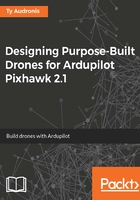
What this book covers
Chapter 1, Drones 101, introduces you to the world of drones and explains that there are many types of drones. We also give you a high-level overview of Ardupilot and Pixhawk flight controller systems. Finally, we walk you through some of the safety best practices to minimize the risks associated with prototyping new drones.
Chapter 2, Your First Drone - An Autonomous RC Car, walks you through kitbashing (using an existing) RC car and turning it into a surface drone (a rover). We show you the basics of designing, 3D-printing, and even molding new parts for your rover to adapt it to Pixhawk. You will be given even more familiarity with the plugs on the Pixhawk 2.1 board and how sensors are attached, as well as a basic overview of the Mission Planner interface. By the end of this chapter, you will have an understanding of how to create a rover using Pixhawk 2.1, a GPS sensor, and a remote telemetry transmitter.
Chapter 3, A Drone for Hunters – Autonomous Duck Decoy, takes the principles of a rover and applies them to the open water. This chapter focuses largely on the process of coming up with a marketable idea and planning your design. You will be shown how to cannibalize parts from an RC boat and implement them into a custom 3D-printed hull (a duck). We will also educate you on the pitfalls of a water drone with regards to waterproofing, ballast, and even water-cooling your drive motor.
Chapter 4, A Drone for Golfers, takes purpose-built rovers to the next level by showing you that drones can fit into almost any market demographic: in this case, golf. We will build a golf trolley on an existing RC golf trolley’s frame and motor system. It implements skid-steering and Bluetooth for telemetry and control, enabling it to follow a golfer that is carrying a phone in their pocket. Also, we will integrate a new sensor: a LIDAR rangefinder that allows the trolley to avoid obstacles while it follows the golfer autonomously.
Chapter 5, Introduction to UAVs, transitions the reader from the surface to the air. Aerial drones represent a whole new level of complexity. With weight considerations, balance, and safety concerns being the focus of this chapter, you will learn to think more like an aeronautical engineer when designing your aerial drones.
Chapter 6, A Simple Multicopter Drone, shows the reader how to build and tune a multicopter drone. We adopt a “GoPro” gimbal (designed to stabilize a GoPro camera) to hold a 360° VR camera (a Ricoh Theta S). We also walk you step-by-step through the Mission Planner interface to get a ground station up and running, which will display a video on a laptop screen, along with the heads-up display and even allows you to fly the drone using gaming joysticks.
Chapter 7, The Holy Grail - A Fixed Wing Drone, walks you through designing and setting up a fixed-wing drone. We will integrate an airspeed sensor (pitot tube) and use a rangefinder again but this time to sense altitude from the ground to assist with autonomous landings. This chapter largely focuses on the Mission Planner software. Using it to tune a fixed-wing drone to fly properly, we will execute autonomous missions and even land with no input from the pilot.
Chapter 8, The Principles of VTOL with Pixhawk, is a bonus chapter added due to the popular demand from the drone community. VTOL (Vertical Takeoff and Landing) drones are airplanes that can also hover and land/take off like a helicopter. Rather than build a drone in this chapter, we walk you through the concepts of planning, building, and tuning a VTOL aircraft.
Chapter 9, Programming Ardupilot, is largely a reference chapter designed to give you quick reference to the Mission Planner interface and all of the basic parameters therein.